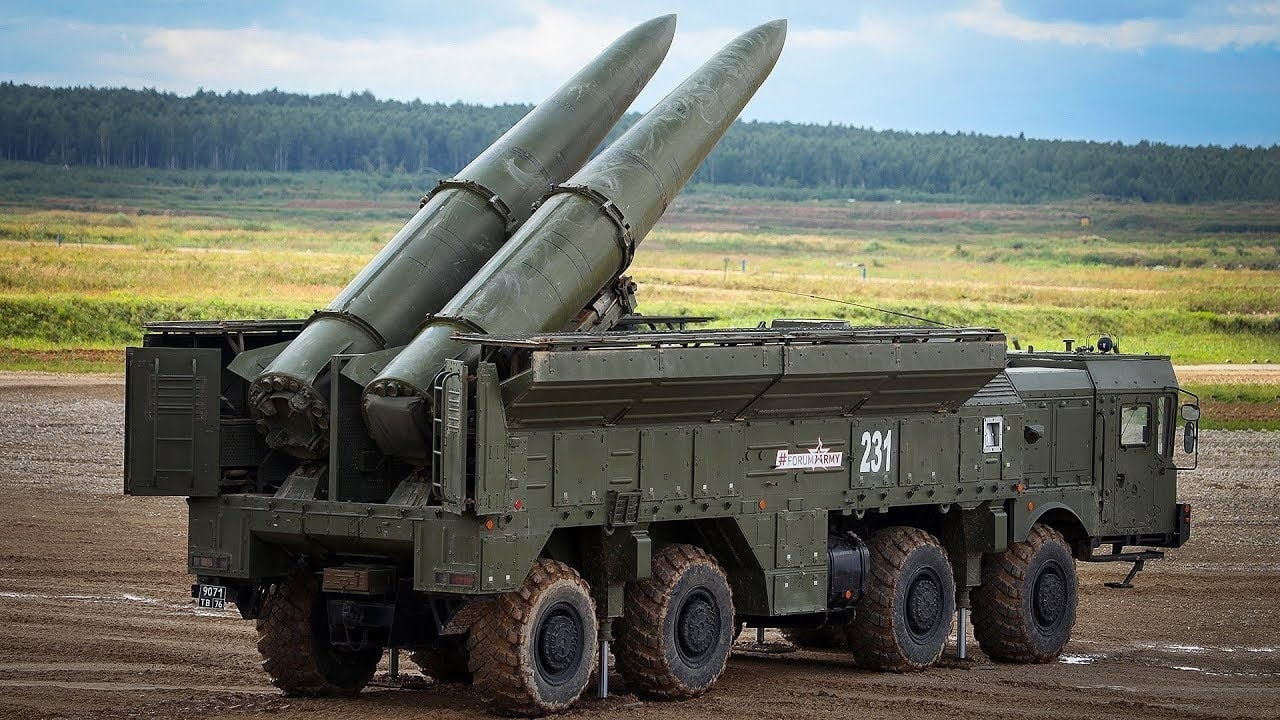Russia’s Iskander Missile Is Creating Terror in Ukraine: Russia has fired hundreds of short-range ballistic missiles at Ukrainian targets since the beginning of the war and Iskander missiles are playing a feature role in this bombardment.
The Iskander-M was used during the 2008 war in Georgia, and they are fast and accurate. Russia has deployed them in Belarus for attacks targeting Kyiv. At least 36 Iskander launchers were seen headed by train to Belarus before the war and more have likely joined the fight. Road-mobile Iskander launchers can also fire cruise missiles. Therefore, Iskanders are versatile and deadly and will be fired into Ukraine as long as the Russians can keep them supplied at the front.
Iskander Can Be Outfitted with Numerous Types of Payloads
In service since 2006, the Iskander system fires 9M723 ballistic missiles with a range of 310 miles. The missiles have a payload of 1,500 pounds with a high-explosive warhead. They can also be outfitted with cluster munitions, nuclear warheads, the horrifying thermobaric “flamethrower” weapon, as well as penetrating bunker busters.
They Have Been Deployed in Impressive Quantities
The launchers are on an 8×8 MZKT-79306 truck chassis. Each three-person vehicle has two missiles. The Russians may have deployed as many 48-launchers in four brigades in Belarus and other locations around the Ukrainian border in the Eastern and Central Military Districts. The Russians may have dozens more launchers.
Difficult to Defend Against
Iskander supersonic missiles can maneuver in flight using inertial and optical guidance. This allows them to hit moving targets. They are not expected to be taken out by Ukrainian air defenses. Iskanders are likely to have already targeted command and control centers, radar installations, and surface-to-air missile sites.
The 24-foot missiles are single-stage with solid propellant that can fly low to the ground. They have an accuracy within 10 to 20-feet. The launch weight is around 8,000 to 9,000 pounds. “Missiles can be launched 16 minutes from traveling or 4 minutes from the highest readiness. The second missile can be launched in less than a minute once the first missile is launched, according to Military Today.
Iskander: The Future of Warfare Is Now
Standoff missiles like the Iskander system are becoming more of a fixture in modern warfare and the Chinese are likely watching how they perform against Ukraine. The bombardment is a historic case study in large-scale, combined arms warfare.
Jeffrey Lewis, from the James Martin Center for Nonproliferation Studies (CNS), told Reuters that “We see some damage at airports, and it looks fairly accurate,” he said.
Can Iskanders Continue to Dominate?
Missiles alone are not likely to completely tip the balance in Russia’s favor. There are just too many targets in Ukraine and not enough supply of short-range ballistic missiles. But they are featured prominently in Russia’s stockpile of weapons and if utilized with a full spectrum of artillery and aerial attacks by the Russian Air Force, they can continue to pound Ukraine. The accuracy is concerning because of all the different kinds of payloads that the Iskander can carry, especially battlefield/ tactical nuclear weapons.
It’s not just in the Ukrainian theater where Iskanders are deployed. They are also in the Russian enclave of Kaliningrad where they can be targeted at Baltic countries.
One surprising development is that Russia did not execute a complete shock and awe bombardment campaign before the land invasion. But Iskanders likely will be a go-to weapon going forward and their road-mobile capabilities and versatile payload will make them a major factor in the duration of the war.
Now serving as 1945’s Defense and National Security Editor, Brent M. Eastwood, Ph.D., is the author of Humans, Machines, and Data: Future Trends in Warfare. He is an Emerging Threats expert and former U.S. Army Infantry officer. You can follow him on Twitter @BMEastwood.

